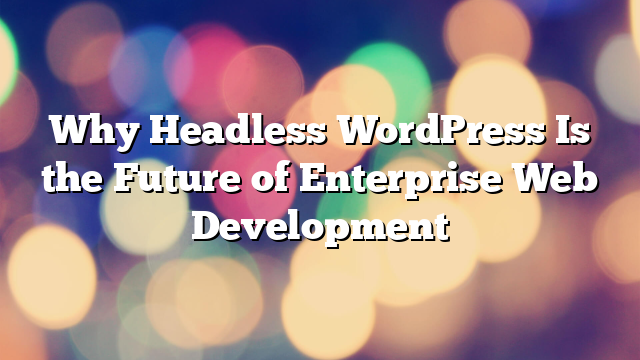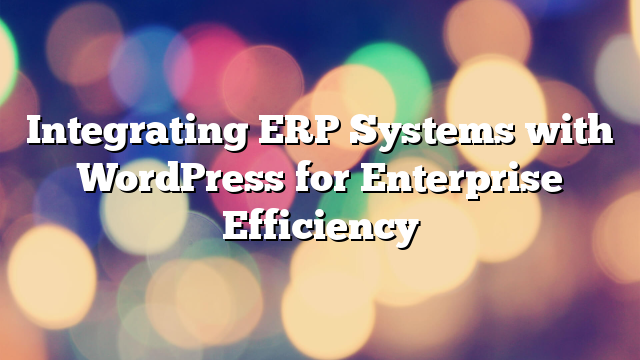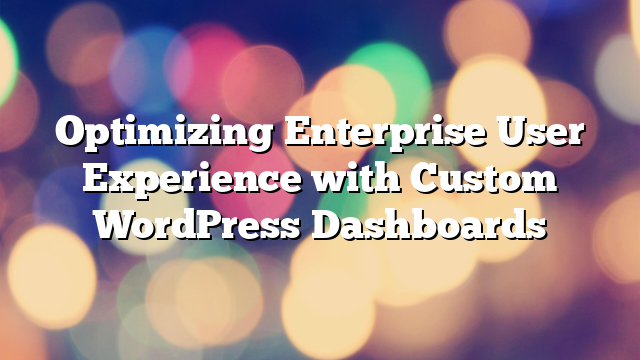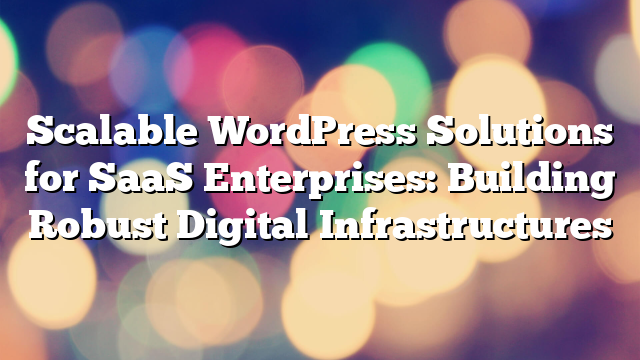Why Headless WordPress Is the Future of Enterprise Web Development
09.01.2025

In the ever-evolving world of web development, businesses are continuously seeking solutions that offer flexibility, scalability, and performance. One of the most significant innovations in recent years is the concept of “headless” WordPress. A headless CMS (Content Management System) decouples the backend from the frontend, allowing businesses to deliver content across multiple platforms with ease. In this article, we will explore why headless WordPress is the future of enterprise web development and how it can transform your digital presence.
What is Headless WordPress?
WordPress is traditionally used as a monolithic CMS, where the backend (content management) and the frontend (website display) are tightly integrated. With headless WordPress, the backend is separated from the frontend, and content is delivered via an API, such as REST API or GraphQL, to any platform or device. This decoupling allows for greater flexibility and a more customized approach to how content is presented across various channels.
In a headless setup, WordPress continues to serve as the content hub, while the frontend can be powered by any technology, such as React, Angular, or Vue.js. This opens up a world of possibilities, as developers can use modern frameworks and tools to create highly interactive, dynamic websites or applications while still relying on WordPress for content management.
1. Improved Flexibility for Multi-Channel Content Delivery
One of the main advantages of headless WordPress is the ability to deliver content across multiple channels. As businesses expand their digital presence, they often need to deliver content not just to websites but also to mobile apps, IoT devices, and even digital signage. With a traditional WordPress setup, this becomes cumbersome and resource-intensive, as separate systems are required to manage content across platforms.
With headless WordPress, content is stored and managed in one place, and can be easily retrieved and displayed across different platforms. For example, a company could manage their blog posts, product information, or marketing materials in WordPress, and then use the REST API or GraphQL to deliver that content to a website, a mobile app, and even an e-commerce platform—all from a single backend.
2. Enhanced Performance with Modern Frontend Technologies
Traditional WordPress themes can sometimes lead to performance bottlenecks, especially for large-scale enterprise websites. Since the frontend and backend are tightly coupled, heavy WordPress themes with multiple plugins can slow down page load times. With headless WordPress, however, the frontend is completely decoupled from the backend, enabling developers to leverage modern frontend technologies like React, Next.js, or Vue.js.
These modern frameworks allow for faster rendering, improved user experience, and optimized performance. For example, Next.js, when used with headless WordPress, allows for server-side rendering (SSR) and static site generation (SSG), which leads to faster page loads and better SEO. Moreover, the frontend can be optimized without worrying about the limitations of WordPress themes or plugins.
3. Scalability for Enterprise Websites
As businesses grow, their digital presence needs to scale accordingly. Traditional WordPress setups can struggle to keep up with high traffic loads or complex content management requirements. With headless WordPress, scalability becomes easier to achieve, as the frontend is independent of the backend, meaning that developers can optimize the performance of each layer separately.
Headless CMS platforms like WordPress also allow for easy integration with third-party services, cloud hosting, and content delivery networks (CDNs), ensuring that your website can handle an increasing number of visitors without sacrificing performance. By using API-driven approaches and modern hosting solutions, headless WordPress provides the scalability necessary for enterprise-level websites.
4. Customizable User Experience and Design
One of the most compelling reasons to adopt a headless WordPress setup is the ability to fully customize the user experience and design. With traditional WordPress themes, there are limitations on how much you can customize the frontend without breaking the theme’s structure. Headless WordPress eliminates this problem by allowing developers to create custom designs and features using modern frameworks, without being constrained by the WordPress theme system.
This flexibility is particularly useful for enterprises that need unique, branded user experiences. Whether you’re building a complex e-commerce website, an interactive product catalog, or a personalized dashboard for users, headless WordPress lets you design the frontend exactly how you want it while keeping WordPress in place as the content management hub.
5. Faster Time to Market
In today’s competitive digital landscape, time to market is crucial. Traditional WordPress development often involves a lengthy process of creating custom themes, integrating third-party plugins, and ensuring compatibility across different browsers and devices. With headless WordPress, developers can focus solely on the frontend experience using modern frameworks and APIs, which speeds up development and allows businesses to launch faster.
Moreover, since the frontend and backend are decoupled, frontend developers can work independently from backend developers, leading to parallel workflows that further accelerate development. This is particularly beneficial for enterprises that need to iterate quickly and respond to changing market conditions.
6. Enhanced Security and Maintenance
Security is a top priority for any enterprise website, and headless WordPress offers an added layer of security compared to traditional setups. Since the frontend is decoupled from the backend, it’s harder for attackers to exploit vulnerabilities that may exist in the WordPress frontend. Additionally, you can implement modern security practices like API rate limiting, token-based authentication, and content encryption to further secure the connection between WordPress and the frontend.
Headless WordPress also simplifies website maintenance, as the frontend can be updated or replaced without affecting the backend. This means that developers can deploy updates, add new features, or redesign the user interface without worrying about compatibility issues or downtime for the content management system.
7. Future-Proofing Your Website
In an era of rapid technological change, businesses need to future-proof their websites. Headless WordPress is a solution that ensures your website is adaptable to new technologies and platforms. Since content is delivered through APIs, you can easily integrate your website with emerging technologies such as voice assistants, augmented reality (AR), and virtual reality (VR) applications. The flexibility of headless WordPress ensures that your website remains relevant and up-to-date, no matter what the future holds.
Conclusion
Headless WordPress is revolutionizing the way enterprises approach web development. By decoupling the frontend from the backend, businesses can achieve greater flexibility, improved performance, and faster time to market. Whether you are looking to optimize your website for multiple channels, scale your digital presence, or deliver customized user experiences, headless WordPress offers the tools and capabilities to meet the demands of modern enterprise websites.
If you’re ready to explore how headless WordPress can transform your enterprise web development, contact AllWebDev for expert guidance and custom solutions tailored to your business needs.



